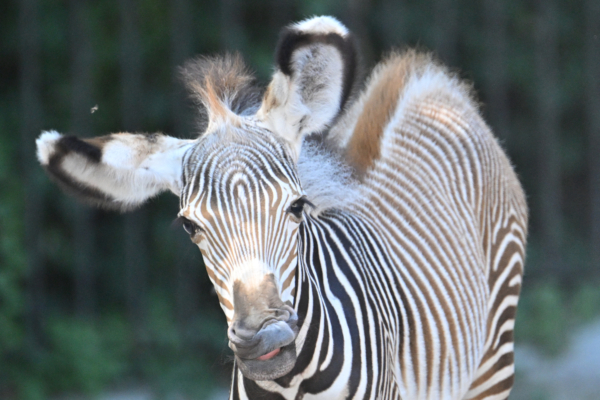In a heartwarming scene at Thornybush Game Reserve in South Africa, visitors witnessed a newborn zebra standing up and taking its first steps in life. According to reports from the Latest Sightings website, photographer Conrad Zeelie and other tourists at the animal reserve witnessed the birth of this young zebra. With the company of its zebra mother and some elephants, the young zebra took its first steps.
Despite being born with long and slender limbs that made it difficult to balance, the young zebra kept trying to stand up, often stumbling in the process, but its mother was always by its side, watching over it.
The gestation period for female zebras is approximately 12 to 13 months, and newborn zebras can weigh up to 40 kilograms.
During the first few hours after birth, the young zebra relies on its mother’s unique scent, stripe patterns, and call to identify her. While adult zebras may look similar to each other in a herd, the young zebra can distinguish its mother from the beginning. The mother’s scent, stripes, and call are unique to the young zebra, helping it stay close and avoid getting lost in the herd.
Zeelie observed as the zebra mother cleaned the young zebra and how it attempted to stand multiple times before finally succeeding. What amazed Zeelie was not only the quickness with which the young zebra stood up but also how it swiftly took its first steps.
Following its mother, the young zebra began to walk forward, unsteadily at first, capturing the attention of everyone around. Within minutes, it bravely faced the challenges of jungle life. The presence of a few nearby elephants made the scene even more beautiful.
In the coming weeks, the young zebra will become familiar with the surrounding wildlife and the potential threats it may encounter.
The first year is the most dangerous period for zebra foals, as they face significant risks from predators and environmental challenges. Strong zebra herds, vigilant mothers, and agile reflexes are crucial for the survival of foals.
The mother zebra seems well-prepared to guide the foal through its initial months and nurture it into adulthood.
Zebra foals grow rapidly, almost reaching the size of their mothers by one year old. Around this time, they start to lead independent lives but remain within the zebra herd.
National Geographic magazine points out that each zebra’s stripe pattern is unique, much like human fingerprints. The average lifespan of wild zebras is around 25 years.
Zebras are social animals and tend to form smaller family groups within a zebra herd, consisting of a stallion, several mares, and their offspring.
Zebras migrate continuously in search of fresh grass and water. Sometimes, they gather in large herds of thousands, migrating to better grazing areas. They often migrate alongside other grazing animals like gazelles.
Zebras groom each other by nibbling at their coats. If you see two zebras standing close and seemingly nipping at each other, worry not, as they are just helping each other tidy up their fur.
In a previous report by Epoch Times, in 2019, a guide and photographer named Antony Tira in Kenya observed a unique newborn zebra in Masai Mara National Reserve. This zebra had circular spots instead of stripes, making it stand out among its kind.

